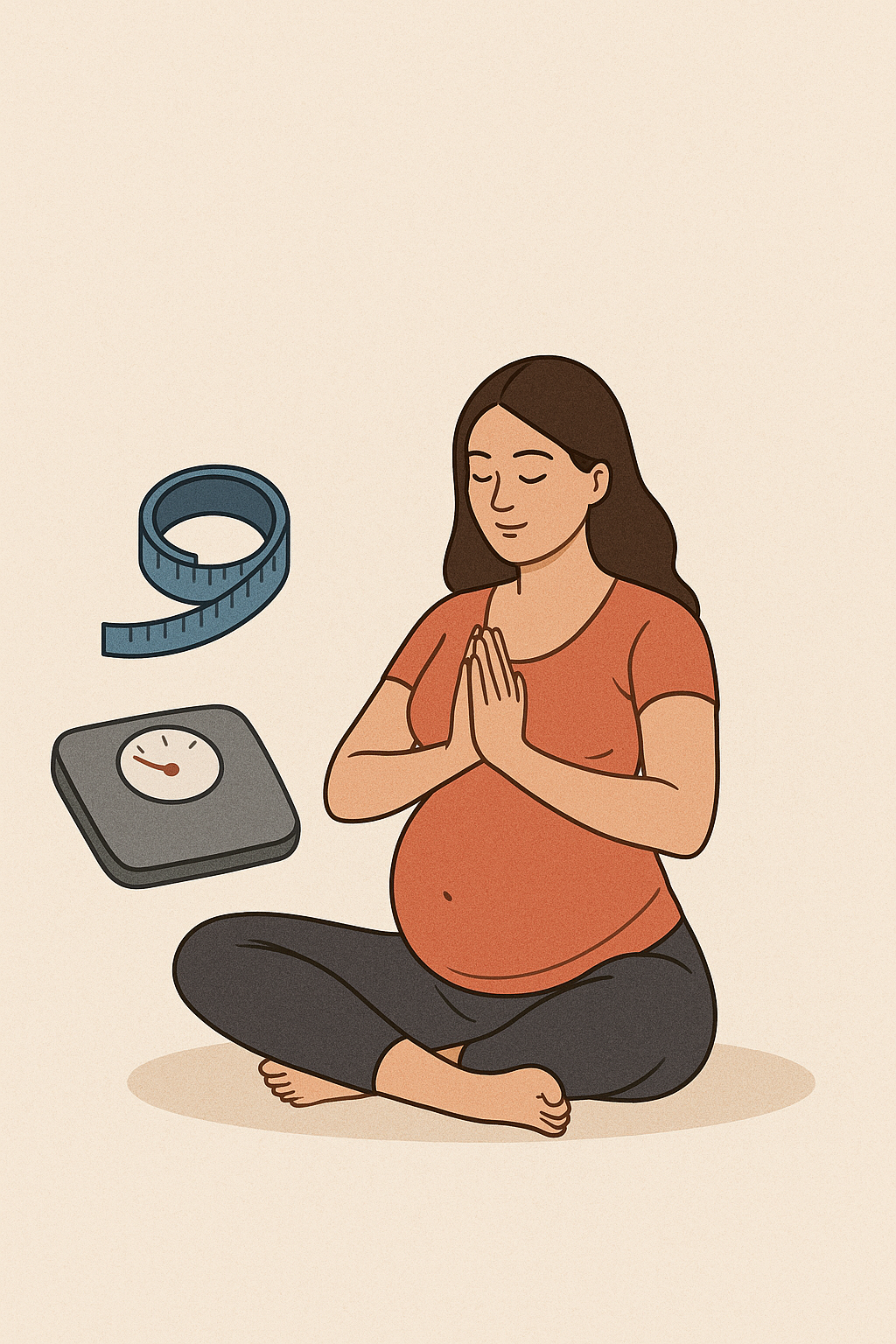THE EFFECT OF KUNDALINI ON MUAC AND BODY WEIGHT IN 1ST TRIMESTER WITH EMESIS GRAVIDARUM

Downloads
Background: Emesis gravidarum is a discomfort that occurs in mothers during early pregnancy. If emesis gravidarum is not adequately managed, children are more likely to experience stunting. There may be negative impact on health from stunting. Stunting is a health problem that is still the government's current focus. Kundalini yoga is a physical activity that focuses on breathing, so it is hoped that it can divert nausea. When the nausea disappears it will be increase appetite so it can impact to a person's nutritional intake, which can be seen from an increase in MUAC and body weight. The purpose of this study is to evaluate whether kundalini yoga is associated with increased MUAC and body weight in women who have emesis gravidarum. Method: This study used a pre-test and post-test control group design as a quasi-experiment that provided kundalini yoga intervention for 15 minutes every day for 30 days. The study population comprised 20–35 year old pregnant women experiencing mild–moderate nausea and vomiting throughout the 1st trimester of their pregnancy. Using the total sampling technique, samples were collected. In this study, body weight gain (BW) and upper arm circumference (MUAC) were the dependent variables, whereas kundalini yoga was the independent variable. The tools used are body measuring tape and body scales. The independent t-test used to examine variations in body weight and upper arm circumference. Result: In the intervention group, the MUAC addition was 0.096 cm, while in the control group, it was 0.012 cm (p = 0.08). Weight gain was 0.512 kg in the control group and 0.952 kg in the intervention group (p = 0.096). Conclusion: Kundalini yoga was not significant in increasing MUAC and body weight.
Abadi, E. and Putri, L.A.R. (2020) ‘Nutrition Assistance Increases the Size of Middle-Upper Arm Circumference of Pregnant Women With Chronic Energy Deficiency’, Public Health of Indonesia, 6(4), pp. 157–162. Available at: https://doi.org/10.36685/phi.v6i4.354.
Abrams, B. and Selvin, S. (1995) ‘Maternal weight gain pattern and birth weight’, Obstetrics & Gynecology, 86(2), pp. 163–169. Available at: https://doi.org/https://doi.org/10.1016/0029-7844(95)00118-B.
ACOG (2020) Morning Sickness: Nausea and Vomiting of Pregnancy, ACOG. Available at: https://www.acog.org/womens-health/faqs/morning-sickness-nausea-and-vomiting-of-pregnancy.
Budiono, N.M., Dewi, D. al and Dewi, S. (2022) ‘ASSOCIATION BETWEEN THIRD TRIMESTER MID-UPPER ARM CIRCUMFERENCE (MUAC) AND ANEMIA IN NEONATUS’, Journal of Widya Medika Junior, 4(3), p. 3.
Connolly, C.P., Mudd, L.M. and Pivarnik, J.M. (2019) ‘Associations Among Work-Related and Leisure-Time Physical Activity With Level of Nausea During Pregnancy.’, American journal of lifestyle medicine, 13(4), pp. 424–431. Available at: https://doi.org/10.1177/1559827617695783.
Dolatian, M. et al. (2020) ‘Weight gain during pregnancy and its associated factors: A Path analysis’, Nursing Open, 7(5), pp. 1568–1577. Available at: https://doi.org/10.1002/nop2.539.
Fitria, H. et al. (2023) ‘Lemon aromatherapy for emesis gravidarum: A systematic review’, 2(1), pp. 8–16.
Harna, H. et al. (2024) ‘Prevalence and determinant factors of Chronic Energy Deficiency (CED) in pregnant women’, AcTion: Aceh Nutrition Journal, 9(1), p. 65. Available at: https://doi.org/10.30867/action.v9i1.1443.
Jeyakumar, A., Ghugre, P. and Gadhave, S. (2013) ‘Mid-Upper-Arm Circumference (MUAC) as a Simple Measure to Assess the Nutritional Status of Adolescent Girls as Compared With BMI’, Infant, Child, and Adolescent Nutrition, 5(1), pp. 22–25. Available at: https://doi.org/10.1177/1941406412471848.
Kaňková, Š. et al. (2023) ‘Associations between nausea and vomiting in pregnancy, disgust sensitivity, and first-trimester maternal serum free β-hCG and PAPP-A’, Hormones and Behavior, 152, p. 105360. Available at: https://doi.org/https://doi.org/10.1016/j.yhbeh.2023.105360.
Kemenkes (2022) ‘Hasil Survei Status Gizi Indonesia (SSGI) 2022’, Kemenkes, pp. 1–150.
Kemenkes RI (2021) Buku Kesehatan Ibu dan Anak. Jakarta: Kemenkes RI.
Khusmitha, Q.N. et al. (2023) ‘Efficacy of the Kundalini Method in Alleviating Emesis Gravidarum during the First Trimester’, pp. 1598–1606. Available at: https://scholar.google.co.id/citations?hl=id&user=WGrKDtUAAAAJ.
Kpewou, D.E. et al. (2020) ‘Maternal mid-upper arm circumference during pregnancy and linear growth among Cambodian infants during the first months of life.’, Maternal & child nutrition, 16 Suppl 2(Suppl 2), p. e12951. Available at: https://doi.org/10.1111/mcn.12951.
Kurniawati, R.N. (2022) FAKTOR-FAKTOR YANG BERHUBUNGAN DENGAN KEJADIAN KEKURANGAN ENERGI KRONIS PADA IBU HAMIL DI UPT PUSKESMAS WINONG TAHUN 2021. Poltekes Kemenkes Yogyakarta. Available at: http://eprints.poltekkesjogja.ac.id/9933/.
Lauche, R. et al. (2016) ‘A systematic review and meta-analysis on the effects of yoga on weight-related outcomes’, Preventive Medicine, 87, pp. 213–232. Available at: https://doi.org/https://doi.org/10.1016/j.ypmed.2016.03.013.
Liu, C. et al. (2022) ‘Emerging Progress in Nausea and Vomiting of Pregnancy and Hyperemesis Gravidarum: Challenges and Opportunities’, Frontiers in Medicine, 8. Available at: https://doi.org/10.3389/fmed.2021.809270.
Lowe, S. et al. (2019) Guideline For The Management Of Nausea and Vomiting In Pregnancy and Hyperemesis Gravidarum, Society Of Obstetric Medicine Of Australia And New Zealand.
Macias, L. (2024) Evolution of Morning Sickness and How it Relates to Maternal Nutrition and Fetal Development.
Mardliyana, N.E. (2022) ‘Peningkatan Pengetahuan Ibu Hamil Tentang Penanganan Keluhan Fisiologis Dengan Media Video Pakbuto (Penanganan Keluhan Ibu Hamil Tanpa Obat) Di Kelurahan Sutorejo Kecamatan Mulyorejo Surabaya’, Jurnal Pengabdian Masyarakat Kebidanan, 4(1), p. 11. Available at: https://doi.org/10.26714/jpmk.v4i1.8894.
van der Meij, B.S. et al. (2017) ‘Poor Appetite and Dietary Intake in Community-Dwelling Older Adults.’, Journal of the American Geriatrics Society, 65(10), pp. 2190–2197. Available at: https://doi.org/10.1111/jgs.15017.
Meylina Djafar and Heny Sulistyowati (2016) ‘HUBUNGAN NAFSU MAKAN, PENGETAHUAN GIZI DENGAN ASUPAN ENERGI, PROTEIN DAN STATUS GIZI DI RUMKITAL Dr. MINTOHARDJO’, STIKes Binawan, 2, pp. 1–9.
Miele, M.J. et al. (2021) ‘Proposal of MUAC as a fast tool to monitor pregnancy nutritional status: Results from a cohort study in Brazil’, BMJ Open, 11(5), pp. 1–11. Available at: https://doi.org/10.1136/bmjopen-2020-047463.
Muchtar, A.S. and Rasyid, I.N. (2023) ‘Manajemen Asuhan Kebidanan Antepartum Ny ”R” Gestasi 7 Minggu 2 Hari Dengan Emesis Gravidarum Di UPT Puskesmas Bajoe Kabupaten Bone’, Jurnal Midwifery, 5(1), pp. 1–10. Available at: https://doi.org/10.24252/jmw.v5i1.35174.
Mustakim, M.R.D. et al. (2022) ‘Impact of Stunting on Development of Children between 1-3 Years of Age.’, Ethiopian journal of health sciences, 32(3), pp. 569–578. Available at: https://doi.org/10.4314/ejhs.v32i3.13.
Neves, P.A.R. et al. (2020) ‘Poor maternal nutritional status before and during pregnancy is associated with suspected child developmental delay in 2-year old Brazilian children’, Scientific Reports, 10(1), p. 1851. Available at: https://doi.org/10.1038/s41598-020-59034-y.
NIH (2024) Yoga: What You Need To Know, National center for complementary and integrative health. Available at: https://www.nccih.nih.gov/health/yoga-what-you-need-to-know.
Suitor, C.W. (1991) Perspectives on nutrition during pregnancy: Part I, weight gain; part II, nutrient supplements, Journal of the American Dietetic Association. Available at: https://doi.org/10.1016/s0002-8223(21)01073-7.
UNICEF (2024) Maternal Nutrition, UNICEF. Available at: https://www.unicef.org/nutrition/maternal#:~:text=During pregnancy%2C poor diets lacking,and developmental delays for children.
Varsa, R.G. et al. (2021) ‘Gastroesophageal reflux disease in pregnancy’, Romanian Journal of Medical Practice, 16(July), pp. 28–31. Available at: https://doi.org/10.37897/RJMP.2021.S3.6.
Ververs, M.-T. et al. (2013) ‘Which anthropometric indicators identify a pregnant woman as acutely malnourished and predict adverse birth outcomes in the humanitarian context?’, PLoS currents, 5. Available at: https://doi.org/10.1371/currents.dis.54a8b618c1bc031ea140e3f2934599c8.
Wei, S. et al. (2022) ‘Low Prognostic Nutritional Index Contributes to High Adverse Events in Preeclampsia.’, Disease markers, 2022, p. 1187742. Available at: https://doi.org/10.1155/2022/1187742.
WHO (2011) Nutrition of women in the preconception period, during pregnancy and the breastfeeding period. Jenewa. Available at: https://apps.who.int/gb/ebwha/pdf_files/EB130/B130_11-en.pdf.
WHO (2015) Global Nutrition Targets 2025 Stunting Policy Brief, WHO. Switzerland. Available at: https://doi.org/10.7591/cornell/9781501758898.003.0006.
WHO (2022) physical activity, WHO. Available at: https://www.who.int/news-room/fact-sheets/detail/physical-activity (Accessed: 20 June 2024).
WHO (2024) Child malnutrition: Stunting among children under 5 years of age, WHO. Available at: https://www.who.int/data/gho/indicator-metadata-registry/imr-details/72 (Accessed: 22 February 2024).
Woldeamanuel, G.G. et al. (2019) ‘Effect of nutritional status of pregnant women on birth weight of newborns at Butajira Referral Hospital, Butajira, Ethiopia.’, SAGE open medicine, 7, p. 2050312119827096. Available at: https://doi.org/10.1177/2050312119827096.
Yosefinata, K., Zuhairini, Y. and Luftimas, D.E. (2022) ‘Association Between Maternal Mid-Upper Arm Circumference and Baby’s Birth Weight’, Majalah Kedokteran Bandung, 54(3), pp. 172–176. Available at: https://doi.org/10.15395/mkb.v54n3.2701.
Zhang, H. et al. (2020) ‘Risk factors of prolonged nausea and vomiting during pregnancy’, Risk Management and Healthcare Policy, 13, pp. 2645–2654. Available at: https://doi.org/10.2147/RMHP.S273791.
Copyright (c) 2025 herdian putri, Atik farokah, Qatrunnada Naqiyyah Khusmitha

This work is licensed under a Creative Commons Attribution-ShareAlike 4.0 International License.
1. The journal allows the author to hold the copyright of the article without restrictions.
2. The journal allows the author(s) to retain publishing rights without restrictions
3. The formal legal aspect of journal publication accessibility refers to Creative Commons Atribution-Share Alike 4.0 (CC BY-SA).
This Journal (e-ISSN 2656-7806) is licensed under a Creative Commons Attribution-ShareAlike 4.0 International License.
















